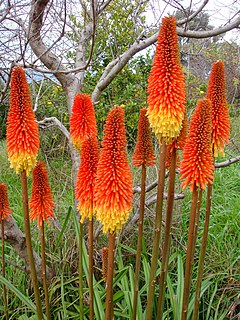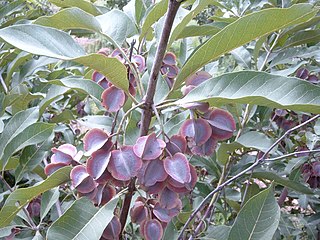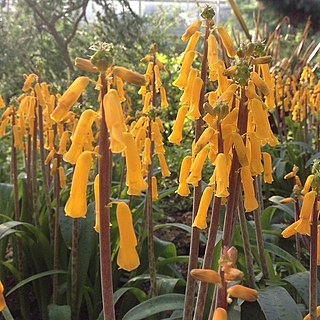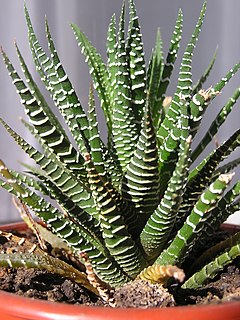
Aloe, also written Aloë, is a genus containing over 560 species of flowering succulent plants. The most widely known species is Aloe vera, or "true aloe". It is called this because it is cultivated as the standard source for assorted pharmaceutical purposes. Other species, such as Aloe ferox, are also cultivated or harvested from the wild for similar applications.

Tulbaghia is a genus of monocotyledonous herbaceous perennial bulbs native to Africa, belonging to the Amaryllis family. It is one of only two known genera in the society garlic tribe within the onion subfamily. The genus was named for Ryk Tulbagh (1699–1771), one time governor of The Cape of Good Hope.

Scilla is a genus of about 50 to 80 species of bulb-forming perennial herbaceous plants in the family Asparagaceae, subfamily Scilloideae. Sometimes called the squills in English, they are native to woodlands, subalpine meadows, and seashores throughout Europe, Africa and the Middle East. A few species are also naturalized in Australia, New Zealand and North America. Their flowers are usually blue, but white, pink, and purple types are known; most flower in early spring, but a few are autumn-flowering. Several Scilla species are valued as ornamental garden plants.

Asphodeloideae is a subfamily of the monocot family Asphodelaceae in the order Asparagales. It has previously been treated as a separate family, Asphodelaceae sensu stricto. The family Asphodelaceae has now been proposed to be a nomen conservandum, and the proposal has been recommended for ratification in 2017. In that case, Asphodelaceae will have priority over Xanthorrhoeaceae. This is reflected in the APG IV family lists.

Kniphofia is a genus of perennial flowering plants in the family Asphodelaceae, first described as a genus in 1794. Species are native to Africa. Common names include tritoma, red hot poker, torch lily and poker plant.

Combretum, the bushwillows or combretums, make up the type genus of the family Combretaceae. The genus comprises about 272 species of trees and shrubs, most of which are native to tropical and southern Africa, about 5 to Madagascar, but there are others that are native to tropical Asia, New Guinea and the Bismarck Archipelago, Australia, and tropical America. Though somewhat reminiscent of willows (Salix) in their habitus, they are not particularly close relatives of these.

Asphodelaceae is a family of flowering plants in the order Asparagales. Such a family has been recognized by most taxonomists, but the circumscription has varied widely. In its current circumscription in the APG IV system, it includes about 40 genera and 900 known species. The type genus is Asphodelus.

Sesamum is a leguminous crop and genus of about 20 species in the flowering plant family Pedaliaceae. The plants are annual or perennial herbs with edible seeds. The best-known member of the genus is sesame, Sesamum indicum, the source of sesame seeds. The species are primarily African, with some species occurring in India, Sri Lanka, and China. The origin of S. indicum is uncertain, as it is widely cultivated and naturalized in tropical regions. The genus is closely related to the strictly African genus Ceratotheca and is itself probably African in origin.

Gasteria is a genus of succulent plants, native to South Africa.

Lachenalia is a genus of bulbous perennial plants in the family Asparagaceae, subfamily Scilloideae, which are usually found in Namibia and South Africa. Most of them have a dormancy period, but new roots will always grow every year.

Dialium is a genus of flowering plants in the family Fabaceae, subfamily Dialioideae. Velvet tamarind is a common name for several species.

Trachyandra is a genus of plant in the family Asphodelaceae, subfamily Asphodeloideae, first described as a genus in 1843. It is native to eastern and southern Africa, as well as to Yemen and Madagascar. Many of the species are endemic to South Africa.
- Trachyandra acocksiiOberm. - Cape Province in South Africa
- Trachyandra adamsonii(Compton) Oberm. - Cape Province, Namibia
- Trachyandra affinisKunth - Cape Province, KwaZulu-Natal
- Trachyandra arenicolaJ.C.Manning & Goldblatt - Cape Province
- Trachyandra aridimontanaJ.C.Manning - Cape Province
- Trachyandra arvensis(Schinz) Oberm. - Angola, Zambia, Zimbabwe, Botswana, Namibia
- Trachyandra asperataKunth - South Africa, Lesotho, Eswatini
- Trachyandra brachypoda(Baker) Oberm. - Cape Province
- Trachyandra bulbinifolia(Dinter) Oberm. - Cape Province, Namibia
- Trachyandra burkei(Baker) Oberm. - Botswana, Limpopo, Free State, Cape Province
- Trachyandra capillata(Poelln.) Oberm. - KwaZulu-Natal
- Trachyandra chlamydophylla(Baker) Oberm. - Cape Province
- Trachyandra ciliata(L.f.) Kunth - Cape Province, Namibia
- Trachyandra dissectaOberm. - Cape Province
- Trachyandra divaricata(Jacq.) Kunth - Cape Province; naturalized in Australia
- Trachyandra ensifolia (Sölch) Roessler - Namibia
- Trachyandra erythrorrhiza(Conrath) Oberm. - Gauteng
- Trachyandra esterhuysenaeOberm. - Cape Province
- Trachyandra falcata(L.f.) Kunth - Cape Province, Namibia
- Trachyandra filiformis(Aiton) Oberm. - Cape Province
- Trachyandra flexifolia(L.f.) Kunth - Cape Province
- Trachyandra gerrardii(Baker) Oberm. - Eswatini, South Africa
- Trachyandra giffenii(F.M.Leight.) Oberm. - Cape Province
- Trachyandra glandulosa(Dinter) Oberm. - Namibia
- Trachyandra gracilentaOberm. - Cape Province
- Trachyandra hantamensisBoatwr. & J.C.Manning - Cape Province
- Trachyandra hirsuta(Thunb.) Kunth - Cape Province
- Trachyandra hirsutiflora(Adamson) Oberm. - Cape Province
- Trachyandra hispida(L.) Kunth - Cape Province
- Trachyandra involucrata(Baker) Oberm. - Cape Province
- Trachyandra jacquiniana(Schult. & Schult.f.) Oberm. - Cape Province
- Trachyandra kamiesbergensisBoatwr. & J.C.Manning - Cape Province
- Trachyandra karrooicaOberm. - Cape Province, Namibia
- Trachyandra lanata(Dinter) Oberm. - Namibia
- Trachyandra laxa(N.E.Br.) Oberm. - South Africa, Namibia, Botswana
- Trachyandra malosana(Baker) Oberm. - Malawi to Zimbabwe
- Trachyandra mandrarensis(H.Perrier) Marais & Reilly - Madagascar
- Trachyandra margaretaeOberm. - Mpumalanga, KwaZulu-Natal
- Trachyandra montanaJ.C.Manning & Goldblatt - Cape Province
- Trachyandra muricata(L.f.) Kunth - Cape Province, Namibia
- Trachyandra oligotricha(Baker) Oberm. - Cape Province
- Trachyandra paniculataOberm. - Cape Province
- Trachyandra patensOberm. - Cape Province
- Trachyandra peculiaris(Dinter) Oberm. - Namibia
- Trachyandra proliferaP.L.Perry - Cape Province
- Trachyandra pyrenicarpa(Welw. ex Baker) Oberm. Huíla Province in Angola
- Trachyandra revoluta(L.) Kunth - Cape Province, Namibia
- Trachyandra sabulosa(Adamson) Oberm. - Cape Province
- Trachyandra saltii(Baker) Oberm. - eastern + southern Africa from Ethiopia to Cape Province; Yemen
- Trachyandra sanguinorhizaBoatwr. & J.C.Manning - Cape Province
- Trachyandra scabra(L.f.) Kunth - Cape Province
- Trachyandra smallianaHilliard & B.L.Burtt - Cape Province, KwaZulu-Natal
- Trachyandra tabularis(Baker) Oberm. - Cape Province
- Trachyandra thyrsoidea(Baker) Oberm. - Cape Province
- Trachyandra tortilis(Baker) Oberm. - Cape Province
- Trachyandra triquetraThulin - Somalia
- Trachyandra zebrina(Schltr. ex Poelln.) Oberm. - Cape Province

Albuca is a genus of flowering plants in the family Asparagaceae, subfamily Scilloideae. The genus is distributed mainly in southern and eastern Africa, with some species occurring in northern Africa and the Arabian Peninsula. Plants of the genus are known commonly as slime lilies.

Pseudogaltonia is a genus of bulbous flowering plants in the family Asparagaceae, subfamily Scilloideae. It is distributed in southern Africa.

Dichapetalum is a genus in the plant family Dichapetalaceae. The plants are tropical lianas native mainly to tropical regions of Africa, Asia, Malesia, the West Indies, Australia and Latin America. Some species are known to be poisonous due to the presence of toxic fluorinated compounds such as fluorocarboxylic acid and dichapetalins, a unique class of cytotoxic compounds that are only found within this genus.

Tulista is a small genus of succulent plants endemic to South Africa. They were formerly included within the genus Haworthia.

Haworthiopsis is a genus of succulent plants in the subfamily Asphodeloideae. The genus was previously included in Haworthia. Species in the genus are typically short perennial plants, with leaves often arranged in a rosette and frequently having raised white markings. The two-lipped flowers are borne on a tall stalk and are small – less than 17 mm (0.7 in) long – and pale in colour. Many species are cultivated as house plants or by succulent enthusiasts.
















